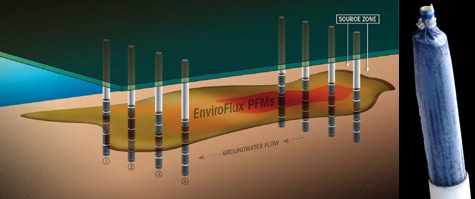Passive Flux Meter™
The EnviroFlux Passive Flux Meter™ (PFM) is a nylon mesh tube filled with a sorbent/tracer mixture. The PFMs are inserted into groundwater monitoring wells where they passively intercept groundwater flow. Inside the PFM is a permeable sorbent that retains dissolved contaminants present in the groundwater. The PFM can be used for a broad range of contaminants (hydrophobic organic compounds, organic or inorganic ions, etc.) by selecting appropriate sorbents. The sorbent mixture is preloaded with specified amounts of resident tracers. The tracers are leached from the sorbent as groundwater flows through the PFM. For common organic contaminants such as chlorinated solvents (TCE, PCE, etc.), activated carbon is used as the sorbent and a suite of different alcohols are used for the tracers.
After a specified period of exposure to groundwater flow (usually one to four weeks), the PFM is removed from the well or boring. The sorbent is then extracted to quantify the mass of all contaminants intercepted by the PFM and the residual masses of all resident tracers. The contaminant masses are used to calculate time-averaged contaminant fluxes, while residual resident tracer masses are used to calculate cumulative groundwater flux. Depth variations of both water and contaminant mass fluxes are measured by a single PFM by vertically segmenting the exposed sorbent mixture and analyzing for resident tracers and contaminants. Thus, at any specific well depth, an extraction from the locally exposed sorbent yields the mass of resident tracer remaining and the mass of contaminant intercepted. In other words the PFM device provides a vertical profile of horizontal fluxes.

ADVANTAGES
• Green Technology — No electrical power or pumping required.
• Simultaneous evaluation of both water and contaminant fluxes
under natural gradient conditions.
• Cumulative measurement of the contaminant flux, making the results
increasingly less sensitive to daily fluctuations in groundwater flow or
contaminant concentrations.
• Only two site visits required.
• Measurement of vertical variations in horizontal fluxes.
• Precise prior knowledge about local aquifer hydraulic conductivities not required.
• Wide range of contaminant analysis.
• USEPA – Approved technology.